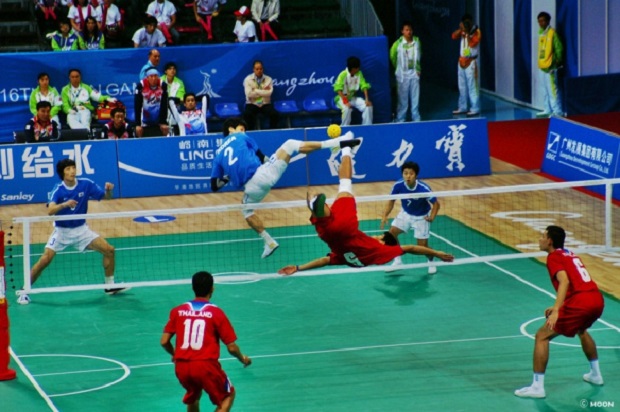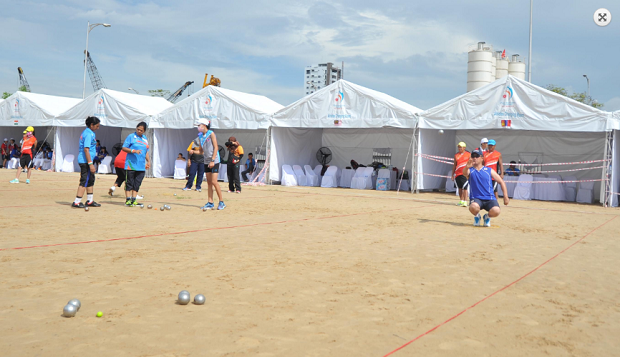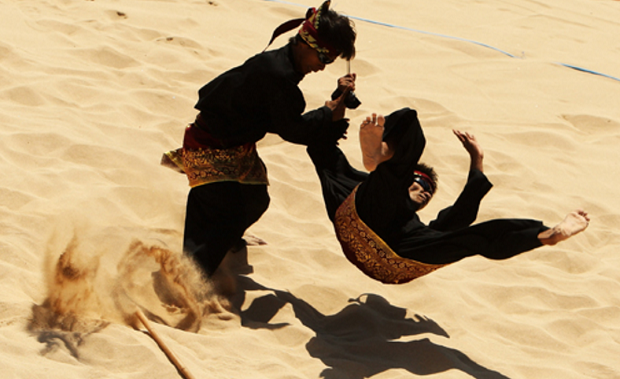Strange sports at ABG5 you've probably never heard of
Football, tennis and swimming have been staples at international sporting events for decades, drawing a large number of spectators. But not many people, especially those living in Western countries, know about the more unusual sports- like pencak silat, for example. These sports may be strange but that’s what makes them so great and fascinating.
Below are some of the lesser-known but fascinating sports at the ongoing 5th Asian Beach Games in Da Nang which is bringing fun and excitement to both local residents and visitors.
Sepak takraw
Sepak takraw or kick volleyball, is a sport native to Southeast Asia. Sepak takraw differs from the similar sport of volleyball in its use of a rattan ball and only allowing players to use their feet, knee, chest and head to touch the ball. It is a popular sport in Southeast Asia.
 |
The name is a marriage of the Malay word “Sepak” (literally meaning “kick” or “smash”) and the Thai word “Takraw” (the original rattan ball used in the sport).
Played on a rectangular court which is of similar size to a badminton court and with a net suspended in the middle, the fundamental rules are simple, with the objective being to deliver the ball over the net into your opponents’ court, and try to make it un-returnable. Players may use any part of their legs, head and torso to handle the ball, but not their arms or hands.
There are several forms of the game, but the most popular is the Regu format, where opposing teams of 5 players (3 on-court with 2 substitutes) line up against each other. The on-court players comprise a Striker, a Server, and a Feeder, each having distinct tactical roles to play during a match, and therefore possessing different playing skillsets.
The new ISTAF tournaments employ the Regu format, where teams play Matches comprising 3 Sets each, with the winner of a Match being the first of the two opposing teams to win 2 Sets. Each Set is played over 21 points. In the event of a score of 20-20, the set shall be won by the side which gets a lead of 2 points, or when a side reaches twenty-five 25 points, whichever occurs first.
Pétanque
Pétanque was born in 1910 in the small Mediterranean fishing port of La Ciotat (Provence). It traces its origins to the Greeks who, on advice of their doctors, took up 'spherique' tossing stone balls for improved strength, flexibility and - the Greeks' uppermost concern - the regular exercise of thought and calculation.
During the 17th and 18th centuries, pétanque was fully integrated into the daily ritual, evolving into more of a competitive sport than a simple diversion.
 |
How to play Pétanque:
- Divide the players into two teams. You can play 1 vs. 1 (3 balls per player); 2 vs. 2 (3 balls per player); or 3 vs. 3 (2 balls per player).
- Have the teams flip a coin to see who starts.
- The starting team draws a circle in the ground - then throws the target ball or cochonnet out to a distance of 6 to 10 meters (19.7 to 32.8 ft).
- The starting team then throws their first boule, trying to get as close as possible to the cochon. Then the 2nd team's player stands in the circle, and tries to get their boule closer to the cochon than the opposing team. They can try to do this by rolling their boule; lobbing it; or even throwing it at the opposing team's boule moving it away.
- Learn that if that team does get a boule closer than any of its opponents, it's called 'having the point' - and then the opposing team has to attempt to throw a boule closer.
- Understand that the team which does not have the closest boule (to the cochon) keeps throwing boules until either they get closest, or they run out of boules to throw.
- When all boules are thrown, only the boules of the one team that are closest to the cochonnet are added to the running score. That is, if team-A 'has the point' and has 2 of it's 3 boules closest to the cochon before then opposing team's boule (in this example, the 3rd closest boule), then team-A gets 2 points added to their score.
- Know that the teams continue to play until a team reaches 13 points (the team which had the point, starts the new round, drawing a circle around the position of the cochon and uses that as the new throwing circle).
Pencak Silat
Pencak Silat ('Silat') is the generic term for the indigenous martial arts of the Indonesian/Malay archipelago, which includes Indonesia, Malaysia, Singapore and Brunei. Silat has played an important role in the history and culture of Indonesian and Malay peoples. Traditionally, Silat formed part of the education of all young men, and was an integral part of a boy's path to manhood.
 |
The combination of the words Pencak and Silat into a compound word was made for the first time when an organization uniting all Pencak and Silat perguruans (institutions) in Indonesia was founded in Surakarta on 18 May 1948.
Silat employs natural body movements and develops balance and economy of movement in each individual. It can be practiced purely for sport and fitness, for the aesthetic beauty of the art or for the chance to learn one of the world's few remaining complete traditional martial arts systems.
Silat enhances and strengthens self-awareness, self-discipline, integrity, responsibility, loyalty and cooperation amongst its practitioners. When taught by a qualified teacher it offers an opportunity for students to develop physically, mentally, morally and spiritually.
Pencak Silat translates to ‘fighting by many techniques of self-defence’ and has four main components:
1. Mental-Spiritual: the performance of Silat enables the practitioner to achieve inner peace and spiritual balance to control body and mind.
2. Self-defence: the performance of skills to defend oneself effectively.
3. Art & Culture: the aesthetic beauty of movements coupled with other elements of arts such as traditional music, costumes and cultural ceremony.
4. Sports: the performance of SIlat as a sport to gain physical fitness and sports achievement. Silat as a martial art is effective system of self-defence using equal emphasis on both upper and lower limb techniques. It involves punching, kicking and dropping of the opponent.
In recent years, Pencak Silat has transcended into many countries outside South East Asia including Holland, Germany, Italy, South Africa, France, Japan and more. The sport has since become a part of many people’s lives and a vehicle to bring people closer. Pencak Silat is well known in many countries outside South East Asia including Holland, Germany, Italy, USA and Japan.
(Source: Da Nang Today/ Internet)